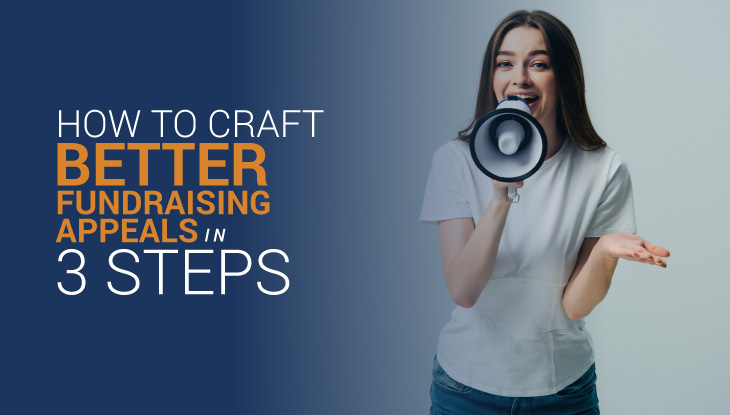
The fundraising appeal is a significant part of communicating with donors to support your mission. As an organization that has made appeals in the past, you understand that it’s crucial to maximize its potential to gain financial support.
When planning an effective fundraiser, remember to account for a fundraising appeal to ask potential contributors for donations.
Popular types of fundraising appeals are general donation requests, sponsorship requests, in-kind donation requests, and corporate donation requests. This can be done both electronically or through direct mail. They’re sent out strategically to specific recipients at intentional times of the year to maximize return.
At GivingMail, we’ve seen fundraising appeals help organizations like yours make a significant impact on communities. We’ve put together three key ways your organization can craft a better fundraising appeal:
- Segment your audience and personalize appeals
- Send your appeals through multiple channels
- Collect and analyze fundraising data
With these tips, your team will be able to make an effective ask to drive your fundraising forward.
1. Segment your audience and personalize appeals
Donor segmentation and personalization are two tools to make your appeals particularly valuable for recipients. Making your outreach authentic and individualized helps your request resonate with the reader.
Donor segmentation is the practice of categorizing donors based on shared characteristics. It’s a key component of achieving the greatest return on investment on the time and money put into communications efforts.
Donor segmentation provides data insights to help your organization discover communication trends within your donor base.. It benefits your communications by:
- Helping your team determine the best way to reach out. For example, segmentation can show you which groups of your audience respond best to certain types of communications Then, you can only send those groups the type of communication they're most likely to respond to.
- Prioritizing certain groups, such as those at risk of lapsing. Organizations aim to increase donor retention as it is cheaper and easier than donor acquisition.
- Giving insights as to which supporters are more likely to give a large gift, helping you focus your efforts accordingly.
By using this tactic, you’ll be showing supporters messaging that they’re likely to engage with. Donor segmentation helps eliminate any outreach that could come across as irrelevant for groups of your audience.
Personalization is when your team customizes an outreach item to an individual. You’ll use data in your CRM to craft a message that includes personal details about the recipient. For example, it may reference the last event they attended.
Other ways personalization works for your team is by including names and personalized donation asks, rather than generalized requests. Specifically, a personalized letter would read along the lines of: “Dear [name],” rather than “Dear valued donor.” This small tactic of tailoring your outreach efforts has the following benefits:
- The recipient is recognized as an individual
- The recipient feels known and acknowledged
- The relationship is strengthened, and the recipient is likely to respond positively
Personalization increases the likelihood the donor will react proactively to your requests. After all, you’re reminding them that they’re a valued member of your organization, and your mission would not be possible without them.
2. Send your appeals through multiple channels
Multi-channel fundraising is a communications strategy that nonprofits can use to spread the word about their appeals campaign. This method works to reach a large audience both online and in-person through multiple platforms. Multi-channel strategies help your team reach people at multiple touchpoints, as to widely broadcast your fundraising message.
The most effective multichannel strategies combine both digital and offline means. Let’s dive into some of the most effective outlets.
Your Website
Your website is the first place supporters will look in order to learn more campaign information after seeing your initial outreach. Use this platform as the main resource for your fundraising campaign information. This means that you should be including your website’s URL as the resource for giving in all of your promotional efforts. Include this information on your social networks, direct mailings, email newsletters, and more.
Direct Mail
Direct mail is one of the most effective fundraising appeal platforms for nonprofits. According to GivingMail’s direct mail statistics, this method accounts for over 90% of direct response revenue to charities. That’s an incredibly high response rate! If that’s not enough, direct mail has a response rate that is up to 10x higher than email or social media marketing for nonprofit organizations.
People react well to receiving a physical fundraising appeal for a multitude of reasons. When your donor looks through their mail, these letters stand out from the digital clutter they see every day. Mail also has a high visibility rate and impact on the reader’s memory. To ensure this is true for your outreach, design your mail tactfully.
To get the most out of your direct mail appeals, consider partnering with a direct mail fundraising platform for low-cost and highly effective physical appeals. They can provide you with the most effective fundraising letter templates for your direct mail, and help you make the most of its effectiveness. Make sure you include easy ways to give in your letter and consider including a pre-paid envelope in your appeals.
Unlike direct mail, with email your team can capture data according to user opens, link clicks, and time spent reading. Email will be a great option for your outreach because it:
- Low-cost method of communication
- Provides readership insights
- The recipient can click directly on your link to donate
Email cannot be a standalone appeal because it has a low response rate due to potential spam filters, or simply getting lost in the largely unread inbox. Segment your donors based on their email response rate data to guarantee that it will be worthwhile to implement into your strategy.
Social Media
There are many routes for your organization to have a social media presence.
Your team can create and manage your social media pages or look into paid social media advertisements. Put your CRM data to use and segment your donors to determine which platforms your supporters use most. Some effective platforms for nonprofit organizations include:
- Facebook. This platform is excellent for writing long-form text posts. There is ample opportunity for your team to write effective copy for a fundraising appeal post. Facebook fundraising is an excellent way to leverage your social media in favor of more donations.
- Instagram. This is designed for your team to post images, videos, and stories. Post content that will promote your impact on the community, highlight donors, and spread the word about your projects. Use your caption text to support the image rather than using the image to support the text.
- Twitter. This platform is a short-form text update site that is used for news, organization updates, and more. Regularly update your Twitter account with content such as shoutouts to donors, fundraising progress, and short, pithy appeals.
It’s likely that the majority of your donors are using social media and are inclined to follow and interact with your organization’s active pages. When they follow you, your content will appear on their feeds. Be sure to include a link to donate in every post, and on your profile pages.
Overall, your marketing strategy should take a multi-channel approach. You’ll be able to reach a wide array of audiences as well as provide easy ways to give.
3. Collect and analyze fundraising data
Make sure you have a donor management software system to collect, analyze, and report on fundraising data. This way, you can see where your current fundraising appeal strategy is doing well and where you have room for improvement.
At GivingMail, we’ve helped a multitude of fundraising organizations maximize their success when making appeals. In our experience, the decisive aspect of your nonprofit fundraising strategy includes effective donor management with the right software. We’ve already discussed the benefits of using data to make donor segments, now let’s explore other important benefits of your data.
- Transform potential supporters into regular donors. Your donor software retains information regarding those who have shown interest in your organization previously. This can include those who:
- Signed up for your newsletter
- Follow your social media but haven’t given yet
- Volunteered at your event but have never made the leap to becoming donors themselves
Now, with supporter data captured by your management software, you can create a group of those you want to reach out to with steps for donating for the first time.
- Cultivate more substantial contributions. Your donor management software can turn a one-time donor into a regular beneficiary. Look at your data insights and determine a group that has potential for these parameters. For example, consider making appeals for slightly larger donations than these supporters have previously made. Another effective method is to implement an automated recurring gift program for repeat donations.
- Monitor the success of your past fundraising appeals. Your software will have data insights from your previous fundraising campaigns. Be sure to see which platform was most effective for your donors, and which you can cut from your strategy to save marketing dollars.
With the right donor management software, your team can base their actions on data, rather than assumptions for a successful future fundraising campaign. When your team makes intentional appeals, you’re able to hit your fundraising goals and cultivate meaningful donor relationships.
With the right practices outlined in this guide, your organization can segment your audience, personalize your fundraising appeals and strengthen your donor connections in the long term. When you leverage multiple channels for outreach, you’re able to make the most of your communication efforts and craft better fundraising appeals.

-3.png)

